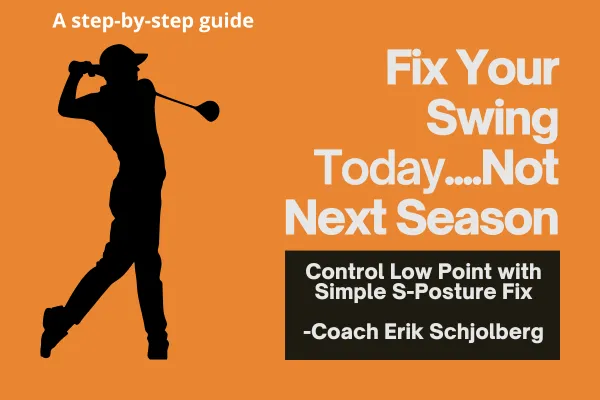EJS GOLF BLOG
Learn about the golf swing and what you can do to improve your score on the golf course. Fill out the form below if you have any questions or want to set up a time to talk.
Mastering the Art of Golf with Coach Erik Schjolberg
I’m Coach Erik Schjolberg, and welcome to the EJS Golf blog—Scottsdale’s authority on science-driven ball-striking. Here you’ll find in-depth analyses of swing mechanics, data-backed breakdowns of impact and launch dynamics, and actionable practice routines designed to rewire your muscle memory from day one. Each post peels back the curtain on cause-and-effect in your swing, whether you’re chasing Tour-level precision, collegiate consistency, or lower weekend scores. Dive into our deep-dive articles, master the drills that drive real improvement, and transform your game with proven science and strategy.
But let’s be clear: golf isn’t only about perfecting swing mechanics. The mental battle you fight on each tee is often the one that determines whether you stay in the game or walk off the course. Here, we’ll tackle the psychological hurdles—the pressure of a tight leaderboard, the frustration when a swing fails under stress, the self-doubt that creeps in after a bad hole. You’ll learn evidence-based mental strategies—visualization routines, pre-shot rituals, stress-management techniques—that fortify your focus and resilience. Mastering these mind-set tools is just as critical as dialing in your impact position, and I’ll show you exactly how to integrate mental training into your practice for lasting confidence on every shot.
Explore Our Blogs

Set a Neutral Pelvis to Control Low Point and Compress Every Iron | Scottsdale Golf Lessons: Fix S-Posture
S-Posture Fix: Set a Neutral Pelvis to Control Low Point and Compress Every Iron | Scottsdale Golf Lessons
Hi. I’m Coach Erik Schjolberg. I teach golfers in Scottsdale, Arizona at EJS Golf at McCormick Ranch and I coach online through The Science of Better Golf. I build ball striking machines. My coaching is about low point control, compressing the golf ball, and producing predictable launch and spin. You should improve on day one. You do not need to get worse first. If you are new to my work, start with my about page, browse the blog, book Scottsdale Golf Lessons, or begin Online Golf Lessons.

The mistake
S-posture is the exaggerated arch in the lower back at address created by excessive anterior pelvic tilt. The lower ribs flare, the lumbar spine over-extends, and the tailbone sits far behind the heels. Many golfers believe this looks athletic because it resembles a weight room hinge. In golf it is a liability. When the lumbar spine locks into extension and the pelvis tilts forward, the body has limited space to rotate and limited ability to use the ground. The swing then compensates with hand action and timing rather than a stable delivery.
Most golfers arrive at S-posture for simple reasons. They were told to “stick the butt out,” so they produced lumbar extension instead of a true hip hinge. They were told to keep the back straight, which they interpret as cranking the lower back rather than organizing the ribs and pelvis. Hip flexor tightness and under active glutes steer the pelvis forward. A handle set too high can push the chest up and the tailbone back, which restarts the same pattern even if the golfer tries to fix it. When this shows up in lessons, I see the same performance cost. Rotation stalls because the pelvis has no room to open. Low point floats because the body cannot post against the lead side in a repeatable way. The handle slows down through impact, the club head overtakes it, and shaft lean disappears. Dynamic loft rises, the strike gets shallow at the wrong time, and contact wanders between fat and thin. Many players also report back discomfort. They are asking the lower back to create posture the thoracic spine should supply.
If this is your address picture, you do not need a new thought in your hands. You need a neutral pelvis and a cleaner rib–pelvis stack. The ball only responds to impact. S-posture corrupts the inputs that create predictable impact.
What actually controls the ball
For irons and wedges, the control variables are clear. The low point must be forward of the ball so contact is ball first then turf. The handle must arrive ahead of the club head, forward shaft lean reduces dynamic loft and increases smash. The club face must be stable through the strike so the start line and curvature are predictable. Those are the outputs. To produce them you need a pressure shift into the lead side and usable ground reaction forces so the pelvis can open and the handle can keep moving. That pressure picture happens early enough that the downswing is not a rescue mission.
A neutral pelvis at address is a high-leverage input because it frees rotation and makes the pressure trace simple. When the pelvis is neutral, the ribs can re-stack over it and the thoracic spine can provide the “proud chest” without forcing the low back to hold the shape. From there the swing can collect the ball with an organized sequence: pressure moves early, pelvis starts to open, the handle keeps moving, and the club head does not pass the hands. On a launch monitor with a 7-iron, typical changes include angle of attack moving from a shallow −1 to −3 degrees toward −4 to −6 degrees, dynamic loft dropping two to four degrees, and a low point that finally lives three to five inches ahead of the ball. Launch lowers, spin normalizes, smash improves, and distance becomes repeatable. None of that requires more effort. It requires better geometry.
My language for this chain is simple. Set neutral pelvis. Stack ribs over pelvis. Use thoracic extension, not lumbar extension. Match the handle height to that shape so you do not re-arch the lower back. Preview a light lead-side bias with irons so pressure can land early in transition. Keep wrist conditions stable so the club face behaves. If you want examples and slow-motion breakdowns, I post weekly on my YouTube channel and cover these patterns inside tsbgolf.com.

The fix I use on day one
I correct posture first because it sets up everything else. The change happens in minutes and you hit shots while we do it so the new pattern anchors to a ball flight, not just a rehearsal.
I start by teaching you to find neutral. Stand tall with feet under the hips. Tuck the pelvis by drawing the belt buckle toward the ribs, then tilt it forward by letting the belt buckle move away. Move between those two extremes twice and settle in the middle. You will feel light glute engagement and a quiet lower abdomen. That is neutral. Next I connect the ribs to the pelvis. Exhale gently so the front ribs soften toward the pelvis, then hinge from the hips without losing that connection. The thoracic spine supplies the structured chest not the lower back. The tailbone points behind you, but the lumbar spine does not crank into extension. I then set your handle height so your arms can hang without the chest re-lifting. If the handle lives too high you will re-arch the lower back. If it lives too low you will crowd the ball and force the wrists to reorganize the face. We find the mid-point that keeps your neutral shape intact. Learning these dynamics changed the health of my spine, made my golf game more consistent and does the same for my students that see the importance of posture.
After address is practiced and demonstrated to be understood, I explain how pressure shifts. With irons, I like a quiet lead-side bias at address that you can still move off during the backswing. That bias reduces the need to lunge during transition and makes it easier to land pressure forward on time. Finally I check wrist conditions and grip. If S-posture has pushed you into a super strong grip to rescue a late club face, we will neutralize it so the face is not closing down through impact. The lead wrist will feel closer to flat to slightly flexed by the top, the trail wrist will feel extended, and those conditions carry through delivery rather than flipping at impact.
This is not theory. In my bay at McCormick Ranch I see the contact line shift forward within the first few balls when we set these pieces. If you want eyes on your pattern and adjustments matched to your body, book Scottsdale Golf Lessons or start Online Golf Lessons. The fix starts on day one. Why wait
A drill
I use a simple progression to hard-wire the change: the Neutral Pelvis Strike Ladder. The goal is to keep the neutral shape you built at address, deliver the handle with forward shaft lean, and move the low point decisively in front of the ball.
Set a mid-iron on a flat lie. Place one alignment stick on the target line for orientation. Place a second stick on the ground three to four inches ahead of the ball and perpendicular to the target line. That forward stick is a low-point marker. If you have a thin towel, set it one inch behind the ball. The towel is your strike audit. Start in the neutral address you rehearsed. Ribs are stacked over the pelvis, the thoracic spine supplies the posture, and the arms are hanging with a handle height that preserves the shape. Make a small backswing to shaft parallel while keeping your chest down enough that the thoracic spine maintains its extension without the lower back taking over. Pause, then make a rehearsal that moves into delivery while you feel pressure land into the lead side and the pelvis begin to open. The handle stays moving, the trail wrist stays extended, and the lead wrist stays flat to slightly flexed. Now hit a half shot with a smooth tempo. The brush of the turf should occur in front of the ball on the far side of the forward stick. If the towel behind the ball moves you did not get pressure forward early enough or you let the handle stall.
Run two more ten-ball sets. In the second set move to three-quarter swings with the same checkpoints. In the third set, go to full swings while keeping the same geometry. Between sets, reset your neutral pelvis and rib stack so you do not drift back toward S-posture. Video from face-on is useful. At impact I want to see the belt buckle beginning to open toward the target without thrusting toward the ball. The hands should be ahead of the club head and the club face should look stable in the small window around impact. With a 7-iron the low point should live three to five inches forward of the ball. When you see a consistent divot starting past the ball and a start line that sits inside a tight window, the drill is doing its job.
If your start line wanders while your contact improves, the fix is simple. Match the grip to the new body delivery. Many S-posture players used a strong grip to save a late face. With a neutral pelvis and earlier pressure landing, the face no longer needs a rescue. Move the grip toward neutral so the face does not over-close through impact. If the towel behind the ball keeps moving, shorten the backswing one club length and exaggerate the lead-side landing of pressure earlier in transition. If you feel the lower back re-arch at address, exhale again, soften the front ribs, lower the handle a touch, and feel the thoracic spine carry the posture.
What changes first
The first visible change is contact. The divot begins after the ball. Fat shots disappear and thin shots become rare. The next change is the flight window. Irons launch a little lower and spin becomes more predictable because dynamic loft is under control at impact. Many players see five to twelve yards of carry gain with a 7-iron because smash improves and curvature tightens. The ball starts closer to the intended line because the club face is not being manipulated late. Players also report less lower-back tension after sessions because the thoracic spine is doing more work and the lumbar spine is no longer cranked into extension for minutes at a time.
These results are normal when the inputs are correct. A neutral pelvis frees rotation. A clean rib–pelvis stack supports that rotation. Early pressure to the lead side allows the pelvis to open, and that opening keeps the handle moving. Forward shaft lean shows up as a consequence rather than a forced position. When you watch your own face-on video and see the belt buckle beginning to open and the hands leading the club head, you will know the geometry is working. If you like seeing numbers, track a few simple ones during practice on a launch monitor. With a 7-iron, angle of attack between −4 and −6 degrees and a consistent low point location tell you the shape is holding. I measure these every day in the bay and through remote coaching, and I publish progress snapshots on the EJS Golf blog and my YouTube channel.
Where to go next
Make the Neutral Pelvis Strike Ladder the opening block of your iron practice. Five to ten minutes is enough to lock the geometry and move on to targets. When contact is consistent, layer in a step-through pattern that increases lead-side braking so the pelvis opens sooner and the handle speed stays organized. If you want a guided build with your matchups, come see me in person in Scottsdale or work with me online. In both formats I provide live coaching, custom drills, and direct feedback. You can begin with Scottsdale Golf Lessons or Online Golf Lessons, and you can learn more about my approach on the about page and inside The Science of Better Golf.
Conclusion
S-posture blocks rotation, floats the low point, and forces timing fixes with the hands. Set a neutral pelvis, stack the ribs over it, and let the thoracic spine carry the posture. Land pressure into the lead side early enough that the pelvis can open and the handle can keep moving. Stable wrist conditions keep the club face calm through impact. When these pieces are present, the low point moves forward, forward shaft lean appears, and you compress the golf ball. If you control low point you control contact. If you control contact you control distance, curvature, and spin. That is how you become a ball striking machine. That is The Science of Better Golf.
Coach Erik Schjolberg (https://ejsgolf.com/about)
The Science of Better Golf (https://tsbgolf.com)
EJS Golf (https://ejsgolf.com)
Scottsdale Golf Lessons (https://ejsgolf.com/Scottsdale-Golf-Lessons)
Online Golf Lessons (https://ejsgolf.com/Online-Golf-Lessons)
What You Can Expect from Our Blog
1. Expert Insights on Swing Mechanics:
With over 25 years of experience as a PGA Professional Golf Instructor, I delve deep into the nuances of golf swing mechanics. My articles break down complex theories into understandable concepts, focusing on ground reaction forces (GRFs), biomechanics, and efficient energy transfer.
2. Advanced Technological Guidance:
Our academy is equipped with state-of-the-art tools like the Trackman 4 Launch Monitor, 3D Pressure Plates, and Hackmotion, among others. On the blog, I share how to leverage these technologies to gain precise feedback on your swing, helping you make informed adjustments and see measurable improvements.
3. Tailored Practice Routines:
My philosophy is built on the belief that improvement should be evident from the first lesson. I advocate a '15 minutes per day' practice model, designed to fit into your busy schedule while ensuring consistent progress. Each blog post aims to offer practice drills and routines that are easy to implement and effective in refining your skills.
4. Real Success Stories:
Read about the experiences of those who have trained at EJS Golf Academy. These testimonials not only inspire but also illustrate the practical application of our teaching methodologies and the real results achieved.
5. Interactive Learning:
We occasionally feature video tutorials and interactive content that allows you to visually grasp techniques and corrections. This blended approach helps reinforce learning and allows you to engage with the content actively.
How Our Blog Helps Golfers Get Better
Every post is crafted with the intent to educate. We cover everything from basic fundamentals to advanced techniques, ensuring there's something valuable for every skill level. By presenting data and evidence-backed strategies, our blog demystifies the 'why' and 'how' behind effective golf training. This analytical approach empowers you to make smarter decisions about your practice and play. We understand that generic advice does not suit everyone. Our blog posts are designed to help you identify your own needs and adapt our techniques accordingly. Whether it’s adjusting your grip, stance, or swing path, you’ll find personalized tips that resonate with your specific challenges. Beyond just reading, our blog serves as a community hub where you can interact with fellow golfers and share your experiences. This supportive environment encourages learning and improvement through collective wisdom.
Join Us on Your Path to Mastery
Whether you’re looking to refine your swing, understand the biomechanics of your body, or simply get more enjoyment out of the game, our blog at EJS Golf Academy is your go-to resource. Bookmark our page, subscribe to updates, and start transforming your game today.
Remember, at EJS Golf, we don’t just teach golf; we craft master golfers. Let’s begin this journey together. Visit us atEJSGolf.com to learn more about our programs and start your training online or at our Scottsdale location. Let’s make every swing count!
DO YOU HAVE QUESTIONS?
Fill out my contact form and I will respond to you within 24 hours.
phone: 480.861.9370 email: [email protected]

I've taken multiple private lessons with Erik and he's been by far the best swing coach I have ever worked with. He has the ability to dissect your swing and make small changes for big improvements. What I love most about his lessons is they go far beyond the 1 or 2 hours you're with him. He follows up with videos of how you can improve at home and on the range. The value he provides is absolutely worth the cost of his sessions. I would recommend any golfer at any level who truly wants to get better to go see Erik.”
- Reanol H.

Erik is the best! and that is not an exaggeration. There has not been a single lesson where I haven't walked out and felt like a far better golfer than before. What can't be praised enough is the effort and dedication that Eric puts into each of his students, as his approach to fixing and improving my golf swing was specific to me. While teaching, Erik takes the extra time to truly dive into what he is trying to convey rather than just telling you, allowing for a better understanding. Beyond the instruction at the course, Erik sends specific drills to you from an app that allows for slow motion replays, letting you break down everything and work on your game at any time. I genuinely mean it when I say that I would recommend Erik to anyone wanting to improve their golf game, as he is not only a top not instructor but also a top notch person who cares about his students.
- Brennan K.

Erik is flat out a great coach and mentor! I highly recommend him! Working from the ground up, my swing is healthier and smooth! I wanted a coach that shared the same main principles as the late Tony Manzoni and Erik hits the mark! Found Erik by listening to the Golf Smarter podcast by Fred Greene and connected with EJS Golf through the Perfect Motion app. Erik is motivated and incredibly gifted at his craft!
- Bryan B., Indiana, USA


